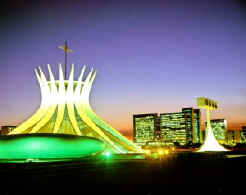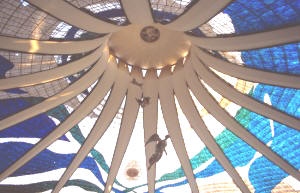

Destinations
Experiences
 |
L A
D A T C O T O U R
S |
 |
||||||||
| HOME | South America | Falkland Islands | Antarctica | Unique Destinations |
Unique Experiences |
Newsstand | ||||
|
 |
Brasilia
|
 |
|
About Brasilia - from the Ministerio do Turismo of Brasil:
Brasilia is located in the Federal District, in the central area of Brazil – the true heart of the Country -, in the State of Goiás. It was not projected just for the sake of being a new capital city. It stands out, in worldwide terms, for expressing the application of the principles established in the Letter of Athens, from 1943 - integrated into a national self-determination and development strategy.
The Brazilian capital is the only city in the world built in the 20th century to be considered, since 1987, a Historical and Cultural Heritage of Humanity by Unesco, an UN agency. And there are plenty of reasons for such renown: the young city, inaugurated in 1960, surprises even the most experienced travelers. Brasilia is the result of a modern urban project designed by Lúcio Costa. If seen from above, the city’s pilot plan resembles the shape of an airplane – many prefer to refer to it as a bird with open wings –, although the architect’s original urban concept appointed to the shape of a cross, to symbolize possession.
The city’s project is up to this day a world reference when the issue is urban planning. The idea of spreading residential buildings around expansive urban areas, of tracing the city plan around large avenues and dividing it into sectors, has produced an intense debate and reflections on life in big cities in the 20th century. The city hosts also a varied assortment of art works from great artists like Bruno Giorgi, Alfredo Ceschiatti, Athos Bulcão, Marienne Peretti, Volpi, Di Cavalcanti, Victor Brecheret and Burle Marx whose works have been integrated into the city’s architecture, making of it an unique landscape. A scenario for political events, music performances and movie festivals, Brasilia is a cosmopolitan city, with around 90 embassies, a wide range of restaurants and complete infrastructure ready to host any kind of event.
Not surprisingly, the city stands out as an important business tourism destination, which is a raising segment of the local economy, crowding dozens of hotels spread around the national capital. Brasilia has a little bit of every corner of Brazil. Building a national capital in the heart of the Country required a large workforce and attracted people from all corners of the national territory. The result is the rich culture of Brasilia, to be appreciated today, a genuine mix uniting the most fun and welcoming people in the world.
Some important points of interest:
Churches
The Metropolitan Cathedral of Brasilia
Designed by Oscar Niemeyer, it was inaugurated in 1970. With a round shape, and being structured around 16 curved pillars filled with beautiful stained glass works, designed by Marianne Peretti – their disposition ensures natural lighting into the aisle, built below street level. Around the church, in the outside area, visitors can see Alfredo Ceschiatti’s sculptures – the four evangelists – and inside, suspended angels. There are also paintings by Di Cavalcanti, representing the stages of the Passion of Christ, and paintings by Athos Bulcão. The Cathedral is located in the Monumental Axle, at the entry of the Ministries Plateau. It is opened daily from 8 am to 7:30 pm. Information: +55 (61) 224-4073. Visits are not allowed during masses.
The Dom Bosco Sanctuary
It is surrounded by 16-meter high arches that support immense stained glass works with many tones of blue. Filled with lighter points of blue, they give viewers the impression of seeing a star spangled sky and of changing places according to the position of the Sun. The central chandelier contains 7,400 Murano glass cups. The Sanctuary was inaugurated in 1963 and is located on Avenue W3 south, court 702. Information: +55 (61) 223-6542. Visits are allowed from Monday thru Friday from 7 am to 7 pm, and on Sundays, from 7 am to 12 pm and from 3 pm to 8 pm.
The Temple of the “Legião da Boa Vontade” (Good Will Legion)
Open 24 hours a day, the construction in the shape of a pyramid has its floors decorated with granite spirals. On the temple’s top ceiling, a 40-cm and 21-Kg crystal stone renders a positive energy to the temple, as idealized by its designers. There is also an Egyptian Room, an art gallery and a gifts store. It is located in the Great Areas South Sector (SGAS), court 915. Information: +55 (61) 245-1070.
Museums
The Central Bank’s Values Museum
It offers a permanent exhibition of national and foreign coins and paper money. It also hosts an exhibition on gold mining showing the largest gold stone found in Brazil, weighing 62 kg. The Museum is located in the Headquarter Building of the Brazilian Central Bank – Banking Sector South (SBS), court 3, block B. Information: +55 (61) 414-2093. It is opened for visits from Tuesday thru Friday, from 10 am to 5: 30 pm and on Saturdays, from 2 pm to 6 pm.
The JK Memorial
As a highlight of the Monumental Axle area, this is a homage to the conceiver and founder of Brasilia, President Juscelino Kubitschek. The memorial’s halls host the museum – with pictures, documents and personal objects related to the life of JK - and the Mortuary Chamber, with the ex-president’s tomb. It is opened from Tuesday to Sunday, from 9 am to 6 pm. It is located in the Monumental Axle, on Cruzeiro Plaza.National Museum of Gems
It hosts a permanent exhibition of Brazilian gems and crystals. It is located inside the TV Tower Panoramic Hall, in the Monumental Axle. It is opened from Monday to Friday, from 10 am to 6 pm, and on Saturdays, from 10 am to 4 pm.
Banco do Brasil Cultural Center – CCBB
It hosts temporary exhibits, art shows and theater and dance shows. It also hosts a snack bar, a gifts store and an auditorium, where this Cultural Center hosts debates on a wide range of issues, including reading tables and other events. It is opened from Tuesday to Sunday, from 12 pm to 9 pm. It is located in the Sports Clubs Sector South (SCES), section 2, lot 22. It is close to the JK Bridge and to the Brasilia Tennis Academy.
The Press Museum
This museum’s greatest highlight is the printing press used by the famous Brazilian writer, Machado de Assis, who worked as book printer during his youth. There are also exemplars of the Official Daily in which the “Lei Áurea” (the Law ending with slavery in Brazil) and the Republic Proclamation Act were published in the late 19th century. It is opened from Monday to Friday, from 9 am to 5 pm. It is located in the Graphic Industry Sector (SIG), court 6, lot 800.
Indigenous Peoples Memorial
It hosts indigenous utilitarian – such as ceramics, vessels and hammocks – and ritual – “cocares” (head accessories used by Brazilian tribes) and collars – works made by indigenous tribes from all over Brazil. The museum is opened from Tuesday to Friday, from 9 am o 5 pm, and on Saturdays and Sundays from 10 am to 5 pm. It is located in the Monumental Axle, on Buriti Square, just across the JK Memorial.
Parks
The City Park – Sarah Kubitschek
Located inside the city’s Pilot Plan, the “Parque da Cidade” (City Park”), extends over four million square meters. It includes landscape works of Burle Marx, and wall tiles that decorate restrooms in the Park designed by Athos Bulcão. Equipped with sports courts, a horse track, a racing kart track, skate tracks, playgrounds for children, bicycle tracks and trails for walks and jogging, the City Park attracts hundreds of people everyday, specially on weekends. The Park’s main entrance is located in the Monumental Axle South, but there are secondary exits that lead to other areas in the city’s South Wing.
The Brasilia Botanical Gardens
It was founded in March 1985 and since then has been through many reformation works to comply with its original philosophical – to be a sample of the “cerrado” (the dry pasture vegetation typical of Central Brazil) landscape -, and technical requirements – to become a space dedicated to research, environmental education and leisure for the city’s population. It offers to visitors the typical vegetation of the “cerrado” area, trails for walks, a belvedere, from where visitors can see almost all the park’s area, and a Visitors Center, which offers support and information those interested in knowing its attractions. There are, for instance, gardens with native and exotic plants, all of which are identified with signaling tags, including also some areas for picnics. It is opened from Tuesday to Sunday, from 9 am to 5 pm. It is located in the Dom Bosco Mansions Sector, complex 12, South Lake – access through the road leading to the city of Unaí. Information: +55 (61) 366-2141. Each visitor must pay a fee to get in, at a symbolic low price.
The Brasilia National Park
It extends over 30 thousand hectares. It is known by locals as “Água Mineral” (Mineral Water) – due to its springs and pools of running water formed out of water pools that emerge from the margins of Acampamento Stream. Besides its natural pools, there is also two trails for walks: the Capivara Trail, being 1,3 km long, and which may be covered in 20 minutes; and the Cristal Água Trail, which requires an one-hour walk to cover its 5-km extension. On calmer days, it is possible to see specimen from the local fauna, such as armadillos, monkeys and “capybaras” (a local large rodent mammal). The Park is opened all through the year, but its best season is between May and October. It is opened from 8 am to 4 pm, and visitors may pay a fee to get it. It is located on Via EPIA BR-040, Urban Military Sector, 9th km.
The Imperial Plateau Park
50 km away from Brasilia, the Imperial Plateau is located inside an “APA” – an Environmental Protection Area. The guided tour goes along trails and waterfalls, with halts for bathing and diving. The tour goes from 9 am to 5:30 pm, including transportation and lunch. It requires booking with antecedence, and visitors should wear sneakers, hat or cap, and solar protectors, bringing also light food for intervals, before and after lunch. Access to the Park is available through the DF-220 roadway, along 50 km, 16 of which run on an unpaved road. It is opened daily from 8 am to 6 pm.